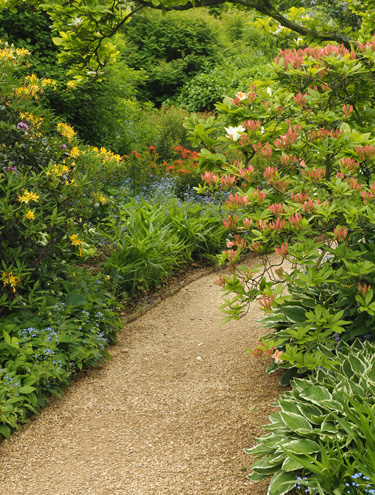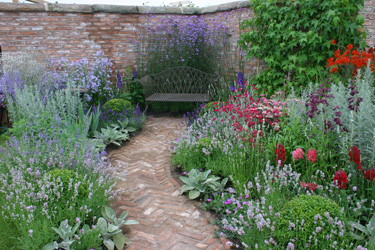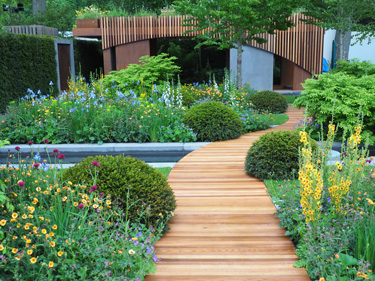Plants for paving
A beautiful garden path combines practicality with a touch of romance.
Whether it’s the track to the front door, a meander through trees and shrubs, a pathway through the vege beds, or the way to the clothes line, any well trodden path and the plants we choose to accompany it have the potential to be one of the most enticing features in a garden.
Well-laid paving is an asset in any garden. For most of us, employing a professional to do the job is a worthwhile investment, but there are still many decisions to make, and lots of surface materials to choose from. It’s worth remembering that expensive paving saves money in the long run as it is usually more durable as well as being easier and economical to maintain than cheaper options. However, when cash flow doesn’t allow a brand new path, an old one can be vastly improved with plants. Even an old cracked path or DIY crazy paving can be transformed with beautiful carpeting plants.
Many plants thrive when they share the same space as rocks, sleepers or paving slabs. Their roots delve below to the cool moist soil beneath the path, and find protection from frost as the path absorbs the suns warmth and radiates it at night.
It makes sense that we would plant some of our favourite plants where we pass most often, but certain attributes are worth thinking about when choosing plants to combine with paving.
Design tips
- One of the most common mistakes with garden paths is to make them too narrow. Allow for plants spilling over onto the pathway.
- Choose a non slip surface for shady pathways or slopes.
- Curving paths have a relaxed feel encouraging us to slow down and enjoy the garden.
- Straight paths are practical for utility areas.
- To discourage shortcuts damaging lawns and gardens, place your path along the most direct line of access.
- Light colours reflect light, but a bright white path can be hard on the eyes on a bright day.
- Dark colours absorb heat and may get too hot for bare feet in summer.
- Mixing paving materials adds interest, but if you want to create a feeling of spaciousness one simple paving material is best.
- Where steps bisect a pathway, use a contrasting trim to draw attention to the change of level.
- Choose a material to suit the need. Main paths need solid durable surfaces that are comfortable to walk on. Pebbles and shells suit light use areas.
- Use low mat-forming plants to soften hard lines.
- Tufts of moss or creeping thyme growing between pavers urges the observer to slow down for a closer look but mounding plants in the middle of a pathway can be dangerous. Keep taller plants to the edges.
Choosing materials
Concrete and tiles are durable and easy care. Surface treatments such as colouring, exposed aggregate and patterned cutting mean concrete doesn’t have to be a boring slab of grey.
Asphalt gives an inconspicuous but hardwearing surface allowing plants to be the main focus of attention. It also wears well, but can be hot to walk on.
Bricks and cobbles allow for interesting patterns and are easier than some other options if you want to lay paving yourself. They are not usually set in concrete so there is more chance of weeds, but loose pavers are ideal if you need to retain access to underground services.
Timber decking is comfortable, warm and easy-care. A boardwalk works wonderfully as a pathway through tricky terrain, or where there is water to cross.
Pebble, shell or gravel surfaces, while not as long lasting, are easy to lay and good for informal or less used pathways. Smooth pebbles are easier on bare feet than sharp gravel or shell.
Great plants for planting around paths and patios:
- Are low growing with close packed growth to block weeds.
- Look good for most of the year.
- Look good when viewed from above.
- Smell good when walked on or brushed against.
Plants for paving |
Approx. height (cm) |
Sun |
Shade |
|
Acaena inermis ‘Purpurea’ |
2 |
✔︎ |
|
Tolerant of light foot traffic |
Ajuga varieties |
5-10 |
✔︎ |
✔︎ |
Easy care foliage perennial |
Alyssum varieties (sweet alice) |
5-10 |
✔︎ |
|
Tolerant of light foot traffic, fragrant. |
Anaphalioides bellidioides (paper daisy) |
15 |
✔︎ |
|
Native for dry or well drained soil. |
Armeria varieties (sea thrift) |
20 |
✔︎ |
|
Good in poor dry soil. |
Bergenia varieties |
20-30 |
✔︎ |
✔︎ |
Leafy evergreen for path sides. |
Blechnum penna-marina (alpine fern) |
15 |
✔︎ |
✔︎ |
Needs watering in hot locations. |
Cerastium tomentosum (snow in summer) |
15 |
✔︎ |
|
Good in poor dry soil. Silver foliage |
Chamaemelum ‘Treneague’ (chamomile) |
5 |
✔︎ |
|
Tolerant of light foot traffic |
Coprosma varieties |
20-40 |
✔︎ |
|
Groundcover shrubs for larger spaces |
Dichondra |
1-2 |
✔︎ |
✔︎ |
Tolerant of light foot traffic |
Geranium traversii varieties |
2-5 |
✔︎ |
|
Native perennial for free draining soil |
Helianthemum (rock rose) |
20-30 |
✔︎ |
|
Cold hardy, ideal for dry borders. |
Heterocentron (Spanish shawl) |
5 |
✔︎ |
✔︎ |
Frost tender. |
Heuchera varieties |
20-30 |
✔︎ |
✔︎ |
Leafy perennials for path sides. |
Leptinella squalida ‘Platt’s Black’ |
1-5 |
✔︎ |
✔︎ |
Strong growing, good between pavers. |
Ophiopogon varieties (mondo grass) |
5-15 |
✔︎ |
✔︎ |
Slow to start growing but tough. |
Pachystegia insignis (Marlborough rock daisy) |
20-30 |
✔︎ |
|
Coastal native for well drained soil. |
Pimelia prostrata (NZ daphne) |
10-15 |
✔︎ |
|
Coastal native for well drained soil. |
Pratia species |
2-5 |
✔︎ |
✔︎ |
Tolerant of light foot traffic |
Salvia varieties (sage) |
20-40 |
✔︎ |
|
Fragrance herb for path edges |
Scleranthus (moss plant) |
2-5 |
✔︎ |
|
Needs sun and good drainage |
Sedum mexicana |
2-5 |
✔︎ |
|
Easy ground carpeting succulent |
Selliera radicans (remuremu) |
2-5 |
✔︎ |
|
Needs moist soil. |
Thyme |
2-5 |
✔︎ |
✔︎ |
Tolerant of light foot traffic |
Viola varieties (perennial violet) |
5-10 |
✔︎ |
✔︎ |
Creeping perennial ideal for damp shade. |
6-Sep-2016

Earthy coloured gravel suits an informal woodland walk

Bricks laid in a herringbone pattern suit a cottage garden.

Concrete pavers combine with gravel in a lawn free courtyard garden.

A timber boardwalk echos the curvature of clipped yew topiary.

Shells and pebbles make reference to the coastal locatin of this garden.


